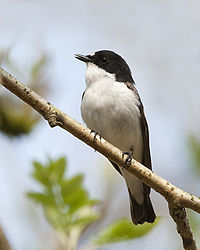
Photo from wikipedia
Food-chain changes in urban and industrial sites may limit breeding-time resources (e.g. food availability) for small insectivorous passerines. We used a long-term data set of pied flycatchers (Ficedula hypoleuca), collected… Click to show full abstract
Food-chain changes in urban and industrial sites may limit breeding-time resources (e.g. food availability) for small insectivorous passerines. We used a long-term data set of pied flycatchers (Ficedula hypoleuca), collected from one of the most polluted sites in Finland during the past 23 years to study the effects of metal pollution on body condition of breeding females. Our results show that body mass started to decline already some days before hatching, indicating a preparation of females to forthcoming chick feeding period. We did not find long-term temporal trends in female body condition index (BCI) in spite of considerably reduced metal emissions during the study period. However, females had higher BCI in polluted than in unpolluted areas during the incubation period. For both incubation and nestling periods the body condition was lower for later breeders, though the condition index decreased slightly faster in relation to hatching date in polluted areas, which may be due to more drastic decrease in nutrition rich food abundance. Temperature and clutch size were positively associated with BCI during the incubation period, but not in the nestling period. Overall, our data suggest that environmental pollution modifies important life-history traits, potentially via indirect effects of higher environmental variability and changed phenology in polluted environment.
Journal Title: Urban Ecosystems
Year Published: 2017
Link to full text (if available)
Share on Social Media: Sign Up to like & get
recommendations!